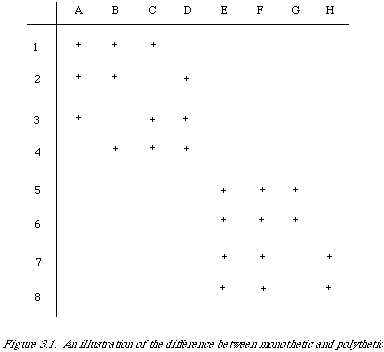|
|
44 |
|
|
|
|
(1) each one possesses a large (but unspecified) number of the properties in G; (2) each f in G is possessed by large number of these individuals; and (3) no f in G is possessed by every individual in the aggregate.'
The first sentence of Beckner's statement refers to the classical Aristotelian definition of a class, which is now termed monothetic. The second part defines polythetic.
To illustrate the basic distinction consider the following example (Figure 3.1) of 8 individuals (1-8) and 8 properties (A-H). The possession of a property is indicated by a plus sign. The individuals 1-4 constitute a polythetic group each individual possessing three out of four of the properties A,B,C,D. The other 4 individuals can be split into two monothetic classes {5,6} and {7,8}. The distinction between monothetic and polythetic is a particularly easy one to make providing the properties are of a simple kind, e.g. binary-state attributes. When the properties are more complex the definitions are rather more difficult to apply, and in any case are rather arbitrary.
The distinction between overlapping and exclusive is important both from a theoretical and practical point of view. Many classification methods can be viewed as data-simplification methods. In the process of classification information is discarded so that the members of one class are indistinguishable. It is in an attempt to minimise the amount of information thrown away, or to put it differently, to have a classification which is in some sense 'closest' to the original data, that overlapping classes are allowed. Unfortunately this plays havoc with the
|
|
|
44 |
|
|
|
